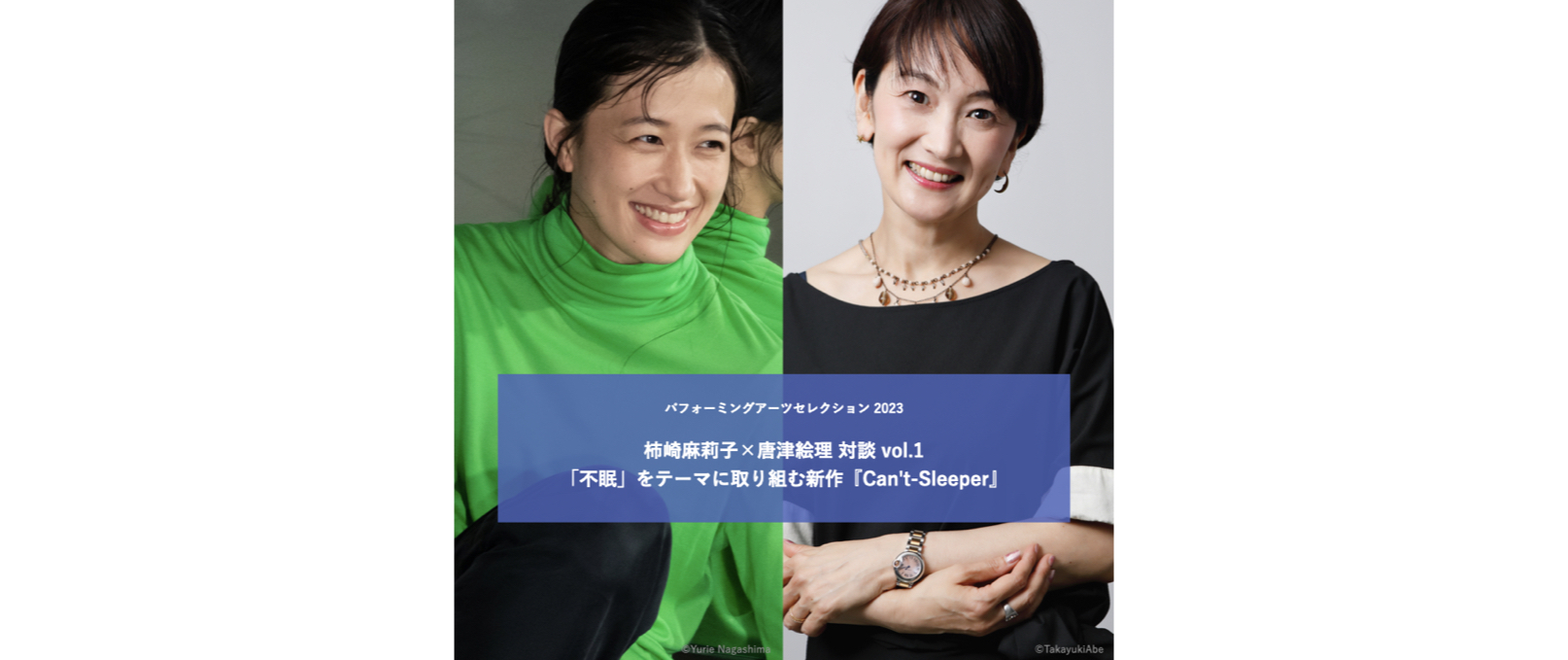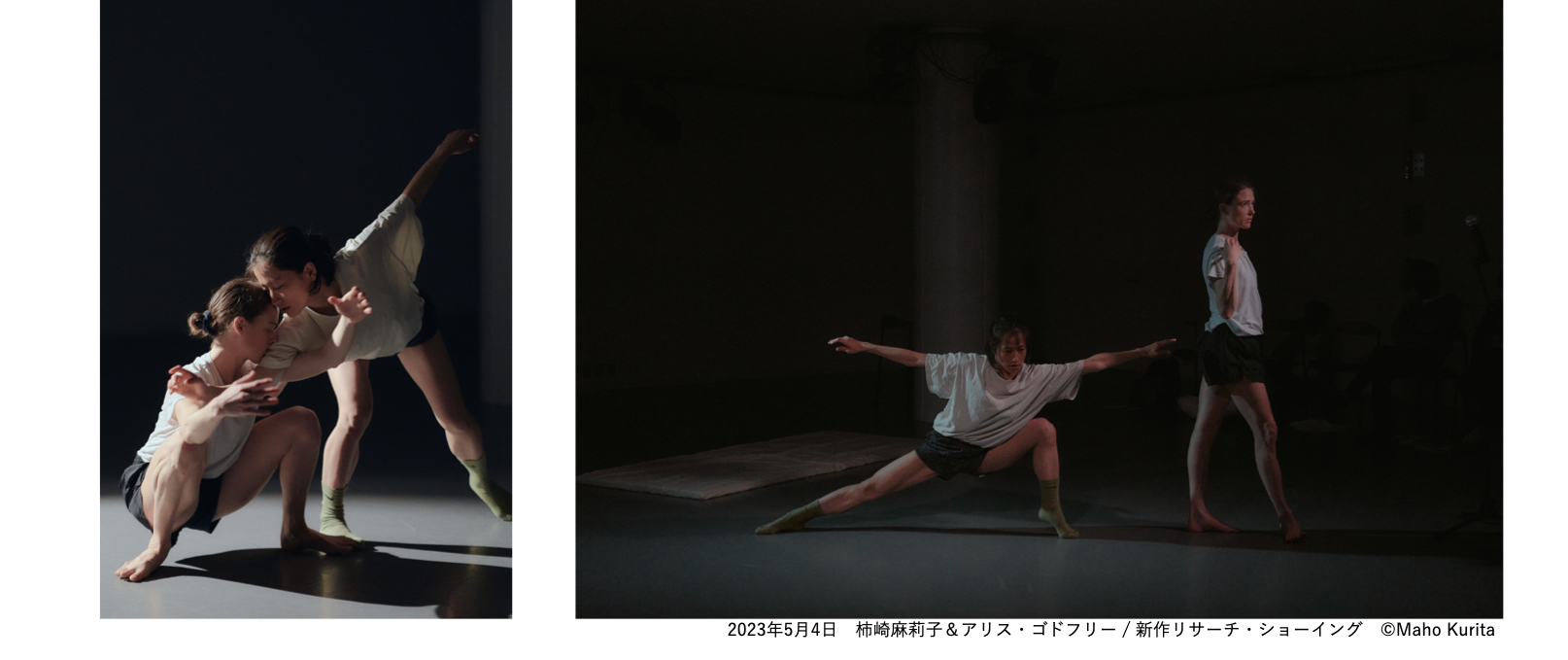PAS2023 Mariko Kakizaki and Eri Karatsu Talk vol.1 “Can’t-Sleeper,” a new work tackling the theme of “insomnia

Presenting his work at the ” Performing Arts Selection 2023 “.A series of conversations with artists.
In this issue, we present vol. 1 of the dialogue between Mariko Kakizaki and Eri Karatsu.
Click here for vol.2
Eri Karatsu (Karatsu ): Thank you for your time today.
The first time I had the pleasure of working with Mariko was in her solo piece “The stillness of the wind” for “Dance Selection 2020” (Aichi Arts Theatre) in 2020. Of course, I knew that Mariko had danced in large cutting-edge companies such as Bat-Sheva Ensemble and Sharone Eyal’s L-E-V Dance Company, but when I first saw this piece, I thought that rather than being a contemporary dancer, Mariko had a primitive body, a body before dance, and a body before dance. When I first saw this piece, I felt a strong sense of the primordial body, the body that existed before dance. In recent years, I have felt that dance works have become more mainstream, especially in Europe, as if to send a message to society through dance, and that they are created from a left-brain perspective that prioritizes the brain rather than the body.
On the other hand, I was very much impressed by Mariko’s words in the text she contributed to this solo work: “I realized later that what I had always been dancing was dancing for the first time. Mariko’s body is very well trained and her technique is wonderful, but she is also thinking about primitive things. I felt the ambivalent coexistence of modernity and primitiveness. I felt that this was at the core of her solo work, and that is why I asked her to perform a solo piece. Three years have passed since the start of DaBY. If the solo piece was Mariko’s starting point, I thought a duo would be a good next step for us to work together.
I know this is a long premise, but when I approached Mariko about the creation of this piece, the idea of dancing with Alice came up. Could you tell us how it came about?
Mariko Kakizaki (Kakizaki): First of all, I love dance very much. I love to see the dancing body, not only the technique, but also the way the person’s heart is moving. I am inspired by such people. So when Mr. Karatsu asked me to create a duet with someone this time, I thought about whose dance I wanted to feel. That was Alice, so before I thought about the theme of the piece, I said, “I want to dance with Alice. I said, “I want to dance with Alice.
Looking back on it now, when I was approached, it was a little over a year after I gave birth, and my postpartum body was still heavy and not fully recovered. My own activities as a dancer were completely different compared to the two or three years before I gave birth when I came back to Japan. I think I was still hungry for the body of a world-class dancer whose body and spirit were in sync with each other, and who could show me fantasy. I wanted to feel such a body close to myself, so I approached Alice. I think what I needed at that time was to feel dance. You decided to dance with Alice, and then the theme was decided.
Karatsu: Mariko, you have worked with many wonderful dancers, but what is it about Alice-san that particularly attracts you? Could you tell us what attracts you to Alice-san?
Kakizaki: First of all, her technique as a dancer is very high. She used to dance with NDT and is now dancing with Sharone’s company, and in terms of physical ability, I think she is at a very high level. At the same time, her energy as a person is very positive, soft, and full of sunshine, and when I see her dance, it is full of warmth. I feel that no matter how sharp she is in her movements, the humanity that she has is there, and there is humor in her movements. It is not a comedic kind of humor, but something comical, cute, and charming, and I think that is what makes her appealing.
Karatsu: You started this project by asking Alice, and this time the theme is “sleep”, where did this theme come from? You mentioned that there was a time when you yourself had insomnia.
Kakizaki: I think that has a lot to do with it. From my own experience of insomnia, I thought that not being able to sleep was an incredibly tough thing to do. I have a little distance from that kind of myself, so I thought I would touch on that experience again. The solo I danced three years ago that Mr. Karatsu just told us about is also based on the sense of my own experience. I was very moved when I saw the ears of rice swaying in the countryside of Kagawa Prefecture, where I spent my childhood. Later, I realized that I was moved by the feeling of dance, and I turned it into a piece of work.
This time, I wanted to incorporate into my work the transformation of the long sleepless nights. At the same time, another reason I wanted to create this kind of work was my experience of doing a “personal dance” as a “School of Care” event for Ms. Yurie Nagashima, a photographer, in March of this year. In that event, several people prepared their favorite music in advance, and I improvised a one-on-one dance with them. I realized then that dance is not only a means of expressing one’s intentions and messages through performance, but also a means of receiving the words and memories of others.
Therefore, when I created this duet work, I first thought about whom I would create it for and with whose thoughts and feelings in mind. Rather than wanting to create a work because I myself have experienced sleepless nights, I wanted to create a work for myself who may have been suffering at that time. I decided on the theme of this work because I thought that if there were people who were in that situation and were having a hard time, it would be nice if I could create a work that would make them feel a little better after viewing it.
Karatsu: That was shared with Alice and decided while talking with her.
Kakizaki: Yes, that’s right. The first time I shared with Alice was when she was in Japan for three weeks this past May for her first creation. The most obvious one was the two-and-a-half-hour showing we were allowed to do at DaBY. I came up with the general program and told Alice what I wanted to do, and she created it. The result was more like a group counseling session than a performance, with everyone in that space spending the same time together and thinking about sleep. I think it was more like a group counseling session. What struck both of us was that about 90% of the people there had experienced insomnia, and after the showing, many of them wrote in the questionnaire that they had thought about going to a hospital, or that they had actually been to a Zen temple. Insomnia” is a subject that is not often brought up on the table, but the fact that each person left their own words after we created such an opportunity made it very meaningful. So this time, even though it is a theater piece, I am hoping that by loudly communicating the theme of “insomnia” issues, it will create an environment where it will be easier to talk about it.

Karatsu: I feel that very strongly. I think people often focus on Mariko Kakizaki’s charm as a dancer because of her wonderful body, but in fact, she also has a very keen sense of society that she carries within her. I consider dance artists to be people who have a high ability to catch what is happening in society with their bodies, and I think the purity of this ability is extremely high. Although they do not suddenly take up the issues in society that you mentioned earlier as themes, I was reminded that they pick up issues from daily life and express them in their works in a natural way.
Kakizaki: I think the birth of my child has also been a catalyst for this, and the birth of my child has made me feel very grounded or more aware of society. While I was an artist, I was equal and could speak my mind on my own terms, and of course I was a part of society, but thankfully I was able to work in a field where I felt less friction for a long time. Later, after I became pregnant, society began to demand that I be a woman and a mother, and I began to feel friction. I had to dare to speak up and think about how I felt. The appearance of the child made me think about how I wanted to confront society as an artist, in a down-to-earth way.
Up until now, I think I have been trying things that were a little far from myself, such as drawing a worldview from my imagination because I like this kind of thing, or trying to do that with my body because I read this kind of story. Perhaps it is partly because I don’t have time to imagine now that I have children.
Karatsu: It’s always been real.
Kakizaki: Yes, I think what I want to create has changed because I live in reality all the time, so sometimes all I can do is create based on what I feel in reality.
■Performing Arts Selection Tour 2023 For more information


